January 4, 2013
by Carole Zangari -
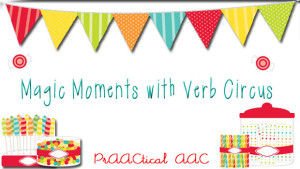
We are so excited to see the expanded web presence by SLPs who are blogging, running groups on Facebook, sharing resources on Pinterest, and maintaining online stores on TeachersPayTeachers. We’ve been thinking about how to connect with some of these creative professionals, both to extend our own professional learning networks and also to broaden the reach of our AAC message. Recently, when an opportunity to forge a few connections presented itself, we decided to collaborate with a few new SLP friends. Periodically, we will be featuring the materials of a fellow SLP who typically writes for colleagues serving primarily children with high incidence disabilities. They post great ideas and materials for students with articulation and phonological difficulties, fluency problems, and language disorders. We hope to put a prAACtical spin on their great ideas. In our inaugural post of this type, we hope to inspire some Magic Moments with fellow SLP Jocelyn... [Read More...]
Filed under: PrAACtical Thinking
Tagged With: Magic Moments, therapy materials, Verb Circus, verbs
January 4, 2013
by Robin Parker -
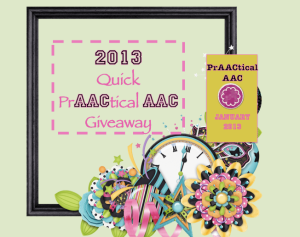
We are so excited for a great 2013 and we have 2 AAC Giveaway Winners! Congratulations! Thank you to everyone who participated and to Therapy Box Apps Scene & Heard- (Scene & Heard) & Enabling Devices/Toys for Special Children #1 Enabling Devices/Toys for Special Children has generously donated a 4-Compartment Scanning Communicator. Please show your appreciation of Enabling Devices by visiting and liking their Facebook page. #2 Scene & Heard- We have one code for the Scene & Heard AAC app that supports multiple languages through voice recordings and supports switch scanning. Scene & Heard takes a visual scene approach to AAC and we are so appreciative to T-Box Apps for donating their app for this giveaway. Don’t forget to show your appreciation by liking their Facebook Page. Enter the Giveaway- How Does It Work? We use Rafflecopter to administer the giveaways. All entries made through there will be counted toward our drawings. Enter now and everyday until... [Read More...]
Filed under: PrAACtical Thinking, Uncategorized
Tagged With: Giveaway, Scanning
January 3, 2013
by Robin Parker -
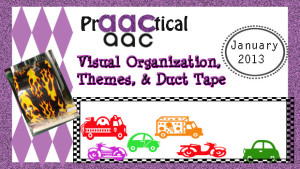
Duct tape just keeps getting better. For full transparency and disclosure, we get nothing and receive nothing from the makers or licenses of any brand of duct tape. We only buy it (although sometimes it might be on sale). We have written about duct tape as a prAACtical behavior strategy, but since that time, the popularity of duct tape as a crafting tool has increased. We are excited not because of the crafting opportunities but instead because we see many more patterns of duct tape in the stores. Any plain duct tape will work as a visual organization tool, but we love that we can add a thematic component to our organization system. Keep in mind, the main point of using duct tape is as a visual organization support. It helps ‘set the stage’ for goal focused interaction and meaningful language experiences. It visually shows expectations. We want learners to... [Read More...]
Filed under: PrAACtical Thinking
Tagged With: Organization, resources, Themes, visual supports
January 2, 2013
by Carole Zangari -
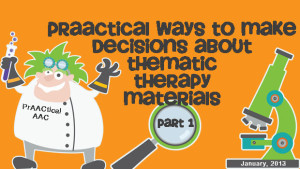
Is it just us, or have other people been blown away by the number of SLPs sharing therapy materials that they’ve designed? It seems like every time we visit sites like Facebook, Pinterest, and TeachersPayTeachers, there are more SLPs posting things that they’ve made. Most of them are incredibly adorable, reasonably priced, and even free. Many are based around a particular theme, such as a holiday or season, or a conceptual theme, such as pirates, the circus, or outer space. We love the cute graphics and fun fonts, and bet that many of you do, too. Cuteness and the ‘fun factor’ are compelling, but which ones are a good fit for your AAC therapy? In this post, we want to open a conversation with prAACtical thoughts about making solid clinical decisions when choosing therapy materials. I’ll be sharing some things that can be helpful when working with kids who have... [Read More...]
Filed under: PrAACtical Thinking
Tagged With: AAC intervention, clinical considerations, clinical decisions, intervetion, materials, pedagogy, theory, therapy
January 1, 2013
by Robin Parker -
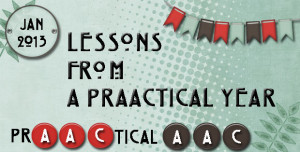
Happy 2013, everyone! It’s hard to believe that we’ve spent a full year of prAACtical blogging. After 375 blog posts, tons of tweets, hundreds of Facebook posts, and numerous resources on our digital curation sites, we are so grateful for all that we’ve learned. Here are some of the highlights. You really DO learn more from your mistakes than your successes. We developed a lot of skills using blog platforms and other resources that we ultimately abandoned in favor of tools that were better suited to our purposes. Walking away from something you’ve invested in is really hard, but it helps to look back on what you learned in the process. In our case, what we learned from those ‘failures’ propelled us toward our goals. It helps to spend time clarifying what you want when looking for new tools/supports. You know that old adage, ‘Look before you leap?’ In hindsight,... [Read More...]
Filed under: PrAACtical Thinking
Tagged With: lessons, new year, plans, reflection
December 31, 2012
by Robin Parker -
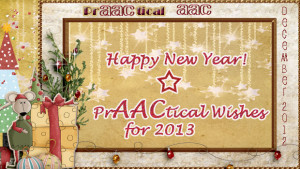
We hope EVERYONE has ACCESS to the: LEARNING TIME MATERIALS FRIENDS ACCOMMODATIONS INCLUSIVE OPPORTUNITIES SUPPORT MENTORS HAPPINESS & FUN That is needed to improve communication and language for the AAC user! We are so excited to begin 2013 full of only the best possibilities!
Filed under: PrAACtical Thinking
December 28, 2012
by Carole Zangari -
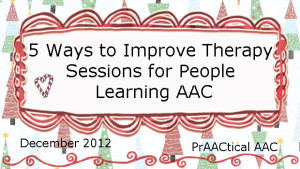
1. Start therapy as soon as you see the client: Savvy SLPs don’t waste a single second of therapy time. As soon as she saw 4 year-old Jonah in the waiting room, Chloe Clinician started sprinkling him with practice opportunities. They used vocalizations and gestures to greet other people. He ‘signed in’ at the front desk using a sheet she made up for Jonah to trace the first letter of his name. She blocked the door with her foot until he told her to ‘open’ and delayed his access to the beloved elevator button until he asked to go ‘up.’ By the time Jonah got to his therapy room, he had practiced skills in 5 different areas. This makes a clinical supervisor’s heart sing! 2. Speak AAC whenever you talk to the client. We’ve been shouting this from the virtual rooftops for quite awhile, but for those who missed it,... [Read More...]
Filed under: PrAACtical Thinking
Tagged With: 5 thing, therapy sessions
December 27, 2012
by Robin Parker -
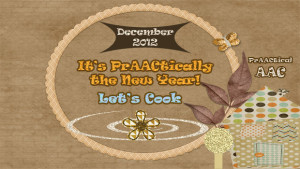
The New Year is almost here. But first is hopefully a big New Year’s Eve celebration whether at home or in the community. We usually bring a home made ‘dish’ with us where ever we ‘go’ or ‘stay’. New Year’s Eve is a family event for us and as we have said before we cook and bake as part of our holiday season traditions. Here are some great visual recipes sites and one new visual recipe from us to you. Special Chef– The recipes are organized with a shopping list, category of food, level of difficulty and lesson guides. Food Tastes Better Outside (Widgit)– Visual recipes for healthy picnic food. Symbolworld Recipe Section– Many recipes simply illustrated using widget symbols. Speaking of Speech Cooking Materials- Visual recipes presented in different ways Chocolate Covered Pretzels- Our recipe on Teachers Pay Teachers. ... [Read More...]
Filed under: PrAACtical Thinking
Tagged With: cooking, Visual Recipes
December 26, 2012
by Carole Zangari -

Sometimes the pages of communication books can be hard to turn, particularly if the pages are stiff or laminated. Here are some tried-and-true methods of putting spacers between the pages to make the books easier for unruly hands to handle. Use a small square of soft Velcro to a corner of the page. The adhesive-backed Velcro makes this a quick and easy fix, and it’s a good way to use up leftover scraps. Foam stickers from a craft or dollar store work well if you only need a small amount of separation between the pages. We love that you can get them in a wide variety of shapes and themes (e.g., dinosaurs, soccer balls, princess crowns). Great way to personalize the book based on your client’s interests. Colorful pom-pom’s can be hot-glued to one end of a paper clip. Use the other end to clip the fluffer to the page.... [Read More...]
Filed under: PrAACtical Thinking
Tagged With: adapted books, literacy, page fluffer, physical access, spacer
December 25, 2012
by Robin Parker -
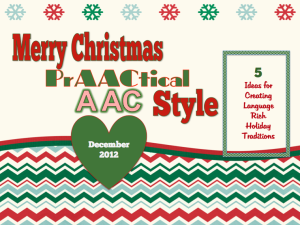
5 Ideas for Creating Language Rich Holiday Traditions The holiday season is a great time to initiate and continue traditions. Since we try to NOT create more work for ourselves if possible, most of our traditions have evolved from activities that helped us at some point. We like holiday traditions because they tend to ease the chaos by building in predictable routines. Each year we talk about traditions (for awhile this was a new vocabulary word), we sometimes write them down, illustrate them, and look at the list at the beginning of the next holiday season. Your family probably has many traditions that might just need to be named and organized. But if you are looking to add some new traditions, here are some of our favorites. If you have any, please share. Photography & Stories– Pictures are a great way to tell a story or talk about... [Read More...]
Filed under: PrAACtical Thinking
Tagged With: language, Traditions









